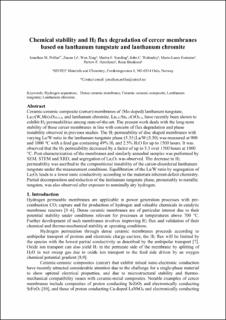Chemical stability and H2 flux degradation of cercer membranes based on lanthanum tungstate and lanthanum chromite
Polfus, Jonathan M.; Li, Zuoan; Xing, Wen; Sunding, Martin Fleissner; Walmsley, John; Fontaine, Marie-Laure; Henriksen, Partow Pakdel; Bredesen, Rune
Peer reviewed, Journal article
Accepted version
Permanent lenke
https://hdl.handle.net/11250/2720614Utgivelsesdato
2016Metadata
Vis full innførselSamlinger
- Publikasjoner fra CRIStin - SINTEF AS [5801]
- SINTEF Industri [1565]
Sammendrag
Ceramic–ceramic composite (cercer) membranes of (Mo-doped) lanthanum tungstate, La27(W,Mo)5O55.5−δ, and lanthanum chromite, La0.87Sr0.13CrO3−δ, have recently been shown to exhibit H2 permeabilities among state-of-the-art. The present work deals with the long-term stability of these cercer membranes in line with concern of flux degradation and phase instability observed in previous studies. The H2 permeability of disc shaped membranes with varying La/W ratio in the lanthanum tungstate phase (5.35≤La/W≤5.50) was measured at 900 and 1000 °C with a feed gas containing 49% H2 and 2.5% H2O for up to 1500 h. It was observed that the H2 permeability decreased by a factor of up to 5.3 over 1500 h at 1000 °C. Post-characterization of the membranes and similarly annealed samples was performed by SEM, STEM and XRD, and segregation of La2O3 was observed. The decrease in H2 permeability was ascribed to the compositional instability of the cation-disordered lanthanum tungstate under the measurement conditions. Equilibration of the La/W ratio by segregation of La2O3 leads to a lower ionic conductivity according to the materials inherent defect chemistry. Partial decomposition and reduction of the lanthanum tungstate phase, presumably to metallic tungsten, was also observed after exposure to nominally dry hydrogen.

